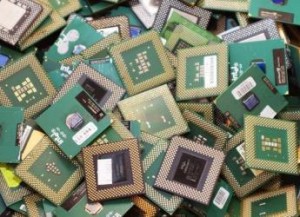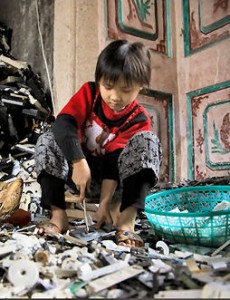6-Jul-2012
United Nations University
 ‘Urban mining’ deposits are 40 to 60 times richer than mined ore, experts tell 1st GeSI and StEP e-Waste Academy in Africa; New PCs, cell phones, tablets, other e-products now use 320 tons of gold, 7,500 tons of silver per year, and rising
‘Urban mining’ deposits are 40 to 60 times richer than mined ore, experts tell 1st GeSI and StEP e-Waste Academy in Africa; New PCs, cell phones, tablets, other e-products now use 320 tons of gold, 7,500 tons of silver per year, and rising
A staggering 320 tons of gold and more than 7,500 tons of silver are now used annually to make PCs, cell phones, tablet computers and other new electronic and electrical products worldwide, adding more than $21 billion in value each year to the rich fortunes in metals eventually available through “urban mining” of e-waste, experts say.
Manufacturing these high-tech products requires more than $16 billion in gold and $5 billion in silver: a total of $21 billion — equal to the GDP of El Salvador — locked away annually in e-products. Most of those valuable metals will be squandered, however; just 15% or less is recovered from e-waste today in developed and developing countries alike.
Electronic waste now contains precious metal “deposits” 40 to 60 times richer than ores mined from the ground, experts told participants from 12 countries at last week’s first-ever GeSI and StEP e-Waste Academy for policymakers and small businesses, co-organized in Accra, Ghana by the United Nations University and the Global e-Sustainability Initiative (GeSI).
Quantities of gold, silver and other precious metals available for recovery are rising in tandem with the fast-growing sales of electronic and electrical goods, including the new category of tablet computers (with 100 million in estimated unit sales this year, a figure expected to almost double in 2014).
With respect to gold alone, electronic and electrical products consumed 5.3% (197 tons) of the world’s supply in 2001 and 7.7% last year (320 tons — equal to 2.5% of the US gold reserves in the vaults of both Fort Knox, Kentucky, and the Federal Reserve Bank of New York).
In that same decade, even as the world’s annual gold supply rose 15% — from about 3,900 tons in 2001 to 4,500 tons in 2011 — the price per ounce leapt from under $300 to more than $1,500.
Thanks to the volume and value of precious metals contained in e-waste, the percentage collected in developing countries is estimated to be as high as 80-90% in countries with an active informal recycling sector, compared with 50% in developed countries.
 However, some 50% of the gold in e-waste is lost in crude dismantling processes in developing countries (compared with 25% in developed countries); just 25% of what remains is recovered using backyard recycling processes (compared with 95% at a modern high-tech recycling facility).
However, some 50% of the gold in e-waste is lost in crude dismantling processes in developing countries (compared with 25% in developed countries); just 25% of what remains is recovered using backyard recycling processes (compared with 95% at a modern high-tech recycling facility).
The bottom line in rich and poor countries alike: just 10-15% of the gold in e-waste is recovered; at least 85% is lost.
Full news release text, click here
Example coverage
Daily Mail, London, click here
Le Monde, Paris, click here
Times of India, click here
Heise, Germany, click here
Agence France Presse, click here (French), here (English) and here (Chinese)
United Press International; click here
ANSA (Italy), click here
Media coverage summary, click here